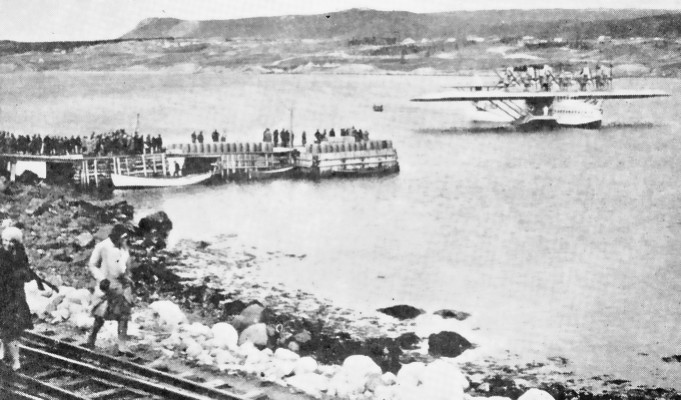
In this photograph, you can see the locals walking along the narrow gauge mainline at Holyrood. A crowd
is out on the dock to see the visiting flying boat with the registration DO-X.
"DO" was short for Claude Dornier's German aircraft company, and "X" was
for experimental, or unknown quantity ... or something ...
Flying boats weren't new - they had been around for more than a decade - particularly in the Canadian bush. However, a German aircraft which had the power and range to show up in Conception Bay, Newfoundland was news ...
The DO-X had flown for the first time in 1929, from the surface of Lake Constance. The 37 ton (55 tons grossed up) flying boat had twelve Siemens air-cooled engines mounted on the top of the wing in six pods. On each pod : one engine faced forward with its propeller in the common fashion, and another faced to the rear with its propeller acting as a "pusher".
Flying boats weren't new - they had been around for more than a decade - particularly in the Canadian bush. However, a German aircraft which had the power and range to show up in Conception Bay, Newfoundland was news ...
The DO-X had flown for the first time in 1929, from the surface of Lake Constance. The 37 ton (55 tons grossed up) flying boat had twelve Siemens air-cooled engines mounted on the top of the wing in six pods. On each pod : one engine faced forward with its propeller in the common fashion, and another faced to the rear with its propeller acting as a "pusher".
"This is no longer a plane, but a ship, a real ship, which is able to lift out of the water and will fly through the air. If you look at it, this giant, incomparably bold work, visions become reality, which were fiction only three years ago."Eventually, they took this aluminum brute on a tour including stops at Portugal, West Africa, Brazil, the Caribbean and the US. They had all kinds of problems with little accidents, and company finances, and ended up buying American Curtiss water-cooled engines to get back home. This photograph was probably taken on their return trip, leaving New York on May 19, 1932 and arriving at Berlin May 24, 1932.
... that probably sounded even more impressive as the shouted, breathless soundtrack of a German newsreel.
(Later, they put the DO-X in the Berlin air museum in 1936. During World War 2 it was too big to evacuate from Berlin with the rest of the aeronautical collection. It was bombed to bits in November 1943 and scavengers recycled the aluminum parts that were left - so don't go looking for it if you are visiting Berlin)
Flying boats galore
The famous American Boeing "Clipper" flying boats and this British Bristol flying boat concept arose during the late 1930s ...
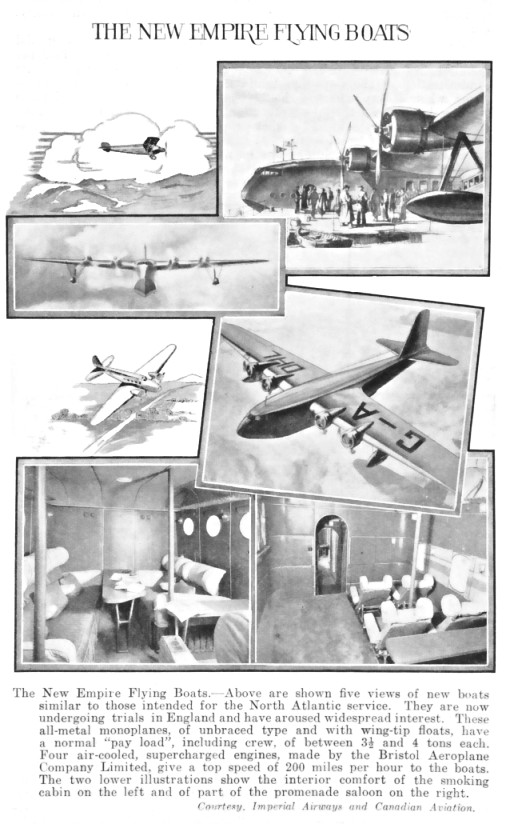
It doesn't look as if this airplane can hold that many people ... So why did they bother to experiment with lumbering, gas-hog flying boats ?
What potential did flying boats have ?
- Flexibility ... when commercial aviation was young ... Flying boats could land wherever there was a stretch of calm water. Long paved commercial runways were not required.
- Safety ... on long trans-oceanic voyages ... A "flying boat" with a mechanical problem could force land on the sea. Flying without modern aviation weather forecasting, a desperate pilot could "pull off onto the shoulder" to deal with wing icing problems. "Desperate" is the key word, because a flying boat flaring to land would be going fast enough to break into pieces or seriously injure the occupants if the wave patterns weren't favourable.
- Prestige ... Countries with distant foreign territories could "show the flag" with luxurious flying boats, rather than using those underpowered hydrogen gasbag airships like the Hindenberg. Oh, the humanity !
- Maritime patrol and rescue ... Future military variants could swoop in to rescue survivors of ship sinkings or aircraft ditchings. Or the positions of enemy ships could be reported to naval authorities for interception.
- Sub killing ... If an enemy submarine was running on the surface (traditionally, the only way they could travel at a reasonable speed) a flying boat could attack with guns, bombs, or depth charges.
Gee, it doesn't take long to turn a new invention into a weapon, does it?
To consider the geography and possible routes for the first trans-Atlantic
airways, have a look at this map from 1923
... I scanned it myself!
... I scanned it myself!
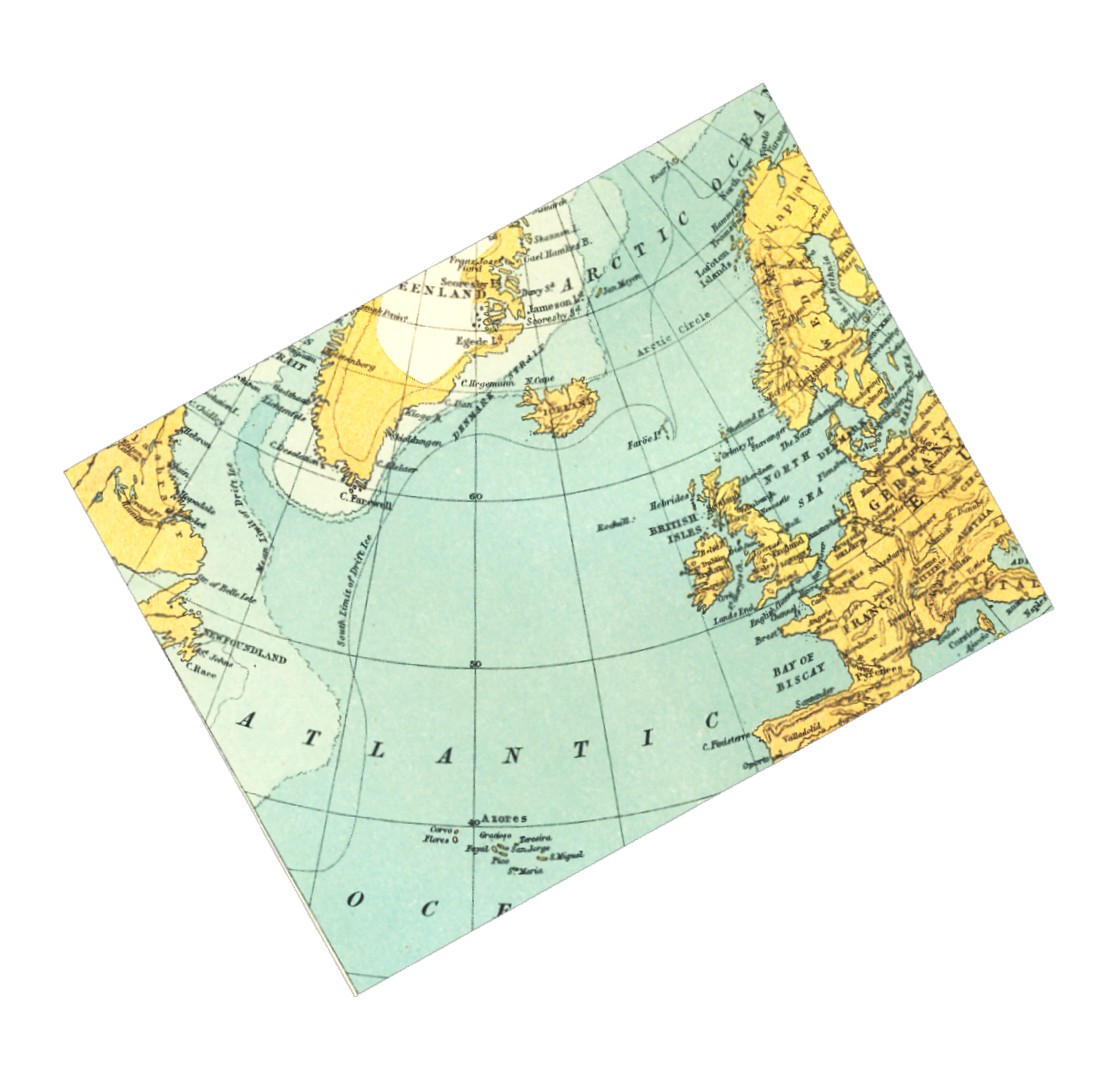
... Newfoundland is always getting cut off someone's map ! ... Newfoundland is as close as North America gets to Europe.
- In 1932, the DO-X was travelling from Newfoundland to Europe via the Azores "gas station" (at the bottom of the map).
- In 1933, Hitler became Chancellor of Germany.
- In 1936, Britain, the United States, Canada, Newfoundland and Ireland (Eire) were working together to set up facilities to support trans-Atlantic aviation. Hoping that ground-based aircraft could be developed to make the trip safely, an area near Gander Lake being hacked out of the bush. It was imaginatively named "Newfoundland Airport".
- July 5, 1937, a Pan Am Clipper flying boat left Botwood, Newfoundland ... and simultaneously ... an Imperial Airways Caledonia flying boat left Foynes, Ireland. Each aircraft flew to the other's starting point as a symbolic first step to scheduled trans-Atlantic flight.
Botwood
Botwood - on Newfoundland's north shore - was already a harbour for the export of the AND Company's newsprint ... and the harbour had rail service. Ramps for taking flying boats ashore, hangers in which to service them, fuel, and weather, radio and control facilities had been established at the Botwood air station.
Botwood was beginning Newfoundland's golden age of aviation :
... as a refuelling station for civilian flying boats on their way to big cities in North America (or heading over to Europe).
... and as a potential military flying boat base.
In 1938, the radio and weather services from Botwood headed east along the Newfoundland Railway for Newfoundland Airport on Gander Lake ... Gander.
Below, you can see the location of the flying boat base at Botwood in the
upper left area of the map. Gander is farther to the east along the
red line, which represents the railway mainline and Newfoundland railway branchlines.
Poor old Holyrood does not appear on this map, but its location is just west
of St. John's, located at the "H" in "Harbour Main".
... While we're at this map, notice the railway branchline to the ocean port
of Lewisporte - located between Botwood and Gander
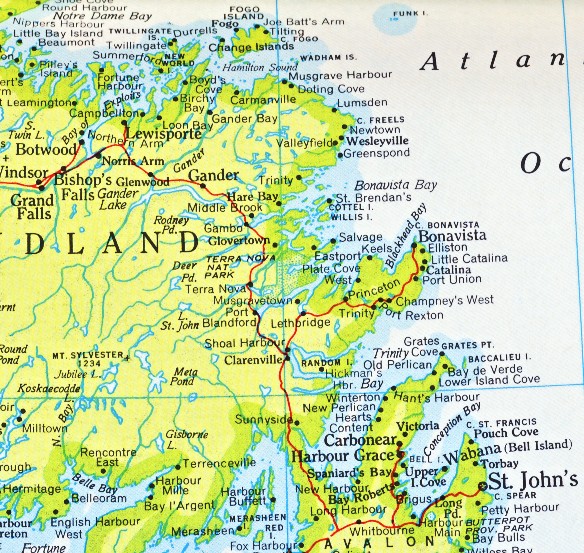
Meanwhile, in bustling Holyrood ...
King George VI (and Queen Elizabeth - later known as the "Queen Mother")
visited Canada, the U.S. and Newfoundland in 1939 - the first reigning British
monarch ever to do so. In Canada, the coast to coast and return railway journey is remembered
by many as a great celebration - particularly by CPR and CNR railway historians.
The whole visit was actually a calculated move to rally North American support ... as political leaders were anticipating yet another European war.
The royal party was travelling back home aboard the CPR liner Empress of Britain between Halifax and Southampton and popped in to Holyrood ... saying they could just stay for a short while. Extra passenger trains had been put on to accommodate those wishing to greet the royal couple as they came ashore near where the German DO-X had landed 7 years previous. The King and Queen then swung aboard a Newfoundland Railway special train to ride the 30 miles into St. John's.
After tramping all around the city in their best clothes - and getting their robes, crowns, and sceptre smelling all like split cod from the waterfront - the King and Queen made a grand departure from St. John's Harbour.
So ... the King and Queen had travelled coast to coast in Canada ... and down to Washington DC ... on the finest railway equipment available to them. Then they had a 30 mile ride on the narrow gauge Newfoundland Railway ! Besides the fact that they were very polite and didn't want to leave anyone out, was there a compelling reason to rally the people of Newfoundland and ride on the Newfoundland Railway ?
Well, Britain certainly owed it to the World War 1 veterans and many surviving families of the Royal Newfoundland Regiment. As well, St. John's excellent harbour had always been a handy spot to tuck in Royal Navy warships.
You could say the King and Queen were "softening Newfoundland up" for the military invasion ... by the British, Americans and Canadians.
They were already storming in : by sea, and by air.
And they would make great demands on the Newfoundland railway ...
The whole visit was actually a calculated move to rally North American support ... as political leaders were anticipating yet another European war.
The royal party was travelling back home aboard the CPR liner Empress of Britain between Halifax and Southampton and popped in to Holyrood ... saying they could just stay for a short while. Extra passenger trains had been put on to accommodate those wishing to greet the royal couple as they came ashore near where the German DO-X had landed 7 years previous. The King and Queen then swung aboard a Newfoundland Railway special train to ride the 30 miles into St. John's.
After tramping all around the city in their best clothes - and getting their robes, crowns, and sceptre smelling all like split cod from the waterfront - the King and Queen made a grand departure from St. John's Harbour.
So ... the King and Queen had travelled coast to coast in Canada ... and down to Washington DC ... on the finest railway equipment available to them. Then they had a 30 mile ride on the narrow gauge Newfoundland Railway ! Besides the fact that they were very polite and didn't want to leave anyone out, was there a compelling reason to rally the people of Newfoundland and ride on the Newfoundland Railway ?
Well, Britain certainly owed it to the World War 1 veterans and many surviving families of the Royal Newfoundland Regiment. As well, St. John's excellent harbour had always been a handy spot to tuck in Royal Navy warships.
You could say the King and Queen were "softening Newfoundland up" for the military invasion ... by the British, Americans and Canadians.
They were already storming in : by sea, and by air.
And they would make great demands on the Newfoundland railway ...
OK, so now Hitler is invading Poland and that is definitely the very last, last straw.
"We" are just about done appeasing ... we mean it !
World War 2 begins ...
"We" are just about done appeasing ... we mean it !
World War 2 begins ...
Great demands on railways ...
During the World War 2, Canadian and American railways were essential for moving troops, raw materials and manufactured goods.
During the war, railways "lived off their capital" as there was little spare
labour or capital available to reinforce or modernize the railway infrastructure ...
and little surplus cash or manufacturing capacity to produce extra railway
equipment to carry the heavy wartime loads ... i.e. the Canadian railways' own shops
were building tanks or naval guns, etc.
So, much of the railways' capital equipment and physical plant were "used up" during the war.
To make things worse, many railways had cut back and deferred new investment during the previous decade of the Great Depression. So many North American railways were relatively sick and weak, and operating outdated technology at the end of Word War 2.
Then the postwar boom, and a new "free" road transportation system, heralded the rubber-tired transportation revolution - with fleets of transport trucks and family cars for everyone.
So, much of the railways' capital equipment and physical plant were "used up" during the war.
To make things worse, many railways had cut back and deferred new investment during the previous decade of the Great Depression. So many North American railways were relatively sick and weak, and operating outdated technology at the end of Word War 2.
Then the postwar boom, and a new "free" road transportation system, heralded the rubber-tired transportation revolution - with fleets of transport trucks and family cars for everyone.
[Please cry a river for the poor railways here]
According to Chief Dispatcher W. J. Chafe of the Newfoundland Railway during the war ...
At the outbreak of World War 2, the Newfoundland Railway had the following equipment :
- 30 locomotives [steam]
- 32 passenger cars
- 250 flatcars
- 250 boxcars
- Stephenville - US Army Air Force
- Argentia - US Navy and USN air station
- Fort Pepperell - US Army, at St. John's
- Gander, formerly Newfoundland Airport - Newfoundland and Britain, with Canada and the USAAF
Whose idea was this?
To skim over a few details ... facing the Battle of the Atlantic, Britain
gave various bits of "Empire land" in Newfoundland and the Caribbean to the US for military
bases ... with 99 year rent-free leases ... in exchange for oldish US warships
... which the Royal Navy would use to escort critical North Atlantic ship convoys, patrol around the
British Isles, and probably keep tabs on the rest of the Empire.
Technically, this agreement kept the US "neutral" in the months before the Pearl Harbor attack changed public opinion in America. Given its importance to the efficient building and support of the military bases, even the Newfoundland Railway scored a little American equipment under this deal !
Technically, this agreement kept the US "neutral" in the months before the Pearl Harbor attack changed public opinion in America. Given its importance to the efficient building and support of the military bases, even the Newfoundland Railway scored a little American equipment under this deal !
The action at Gander
Below, at Gander station during the construction boom ... it looks as if one,
maybe two, of the daily Expresses have arrived. The old wood frame coaches
of the Newfoundland Railway, with their clerestories, are likely lit inside
at night by kerosene, maybe gas. They are probably typical of most of the passenger
rolling stock in Newfoundland. Taken on a warmish day, the photographer's
vantage point is probably another piece of railway equipment. I see no women
in the photograph.
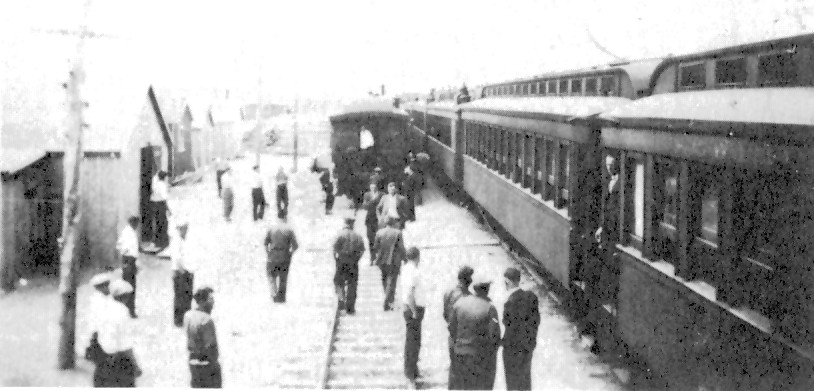
So ... let's build an airport in the middle of the bush ! ...
What'll we need ... to bring in by rail ?
What'll we need ... to bring in by rail ?
Rough list for clearing the land :
- workers
- land clearing tools and tractors to pull stumps and prepare the ground
- gasoline.
- Of course ... somewhere for the workers to live ... summer and winter.
- Gee, almost forgot ... coal and firewood to keep warm, FOOD !
Rough list for facilities to support modern construction equipment, military barracks, some family accommodation, health care, sanitation, power generation, heat, construction of railway spurs into the base :
- lumber
- cement
- crushed rock
- sand
- structural steel
- dynamos
- shielded copper wire
- transformers
- floodlights to permit work at night
- copper pipe
- steel and ceramic pipe
- boilers, fireboxes, valves and gauges
- water pumping and storage facilities
- roofing material
- plaster
- glass and windows
- beds and furnishings
- more coal
- more gasoline ... and diesel fuel for modern construction equipment
- more food
- more motorized construction equipment : cranes, bulldozers, graders, power shovels and snow clearing equipment !!
- cars, trucks, buses, tires, motor oil and grease, spare parts - not too many cars because there will be no roads to the outside for years
- dog teams and sledges [not kidding !]
- more people
- tons and tons of crushed rock, sand, asphalt, and cement for roads and runways
- some rock crushers
- more dump trucks and road rollers
- fencing, gates, barbed wire
- steel aircraft hanger fabrications
- runway lights, signal flares, signal lamps
- mess hall equipment
- ammunition and secure storage facilities, weapons
- meteorological equipment and maps
- mountains of paper forms and books, typewriters and ribbons, pens, pencils, paper clips, blackboards and chalk
- morse and telephone communication equipment and switching gear
- radio transmission gear for morse and local direction finding beams... steel towers and aerials
- aviation gasoline storage tanks and aviation gasoline to fill them
- refueling "bowsers"
- runway fire protection equipment
- aircraft spare parts
- aircraft hydraulic fluid, engine oil, and grease
- retail goods for sale, including periodicals
- religious furnishings and supplies
- more gasoline, diesel, coal and food
- military personnel and all their personal equipment and belongings
- recreational supplies, liquor
From 1957, here is a local employee timetable to show the railway features.
- As indicated, the mileages are measured from St. John's.
- Gander (no longer named Newfoundland Airport) is about 200 rail miles from St. John's.
- Considering all the railway car switching activity in the area - continuing after the war in 1957 - restricted speed (max 15 mph) was required on 7 miles of mainline track at Gander.
- In 1957, Gander's yard tracks could hold 329 freight cars and there were specialized spurs into the airport, including a coal dump spur.
- Much of the crushed rock for the buildings and runways came from a pit a few miles east of Gander along the line - Hall's Quarry.
- At mile 244, at Notre Dame Junction, a 9 mile branch ran to the overworked seaside port of Lewisporte. Most of the fuel, coal and most large manufactured items came through Lewisporte.

The "Finest Hour" of the Newfoundland Railway
- From St. John's, Lewisporte or Port-aux-Basques ... almost everything and everyone required for the airport, came to Gander by train. At its peak, there were 15,000 people at Gander during the war.
- Meanwhile, the other bases were being constructed at Stephenville, Argentia and St. John's - at least these had direct ocean access for the imported goods, decreasing some demands on the railway.
- Newfoundlanders themselves were travelling in increasing numbers to and from the new jobs associated with the various construction projects and operating military bases.
- Newfoundland's typical exports were needed in greater quantities because of wartime demand.
- Remember that the railway did not have very much rolling stock or modern equipment ... and narrow gauge cars and locomotives are smaller and have less capacity.
- The whole thing was operated by timetable and rulebook ... and train movement orders were sent by by telegraph.
- A rare railway train order telephone was installed at the Gander coal dump to issue the routine train orders to return to Lewisporte. Switching congestion at Gander station had often delayed these orders in the past.
- Between Gander and Lewisporte, 15 flatcars (what the railway could allocate) were constantly shuttling back and forth with freight for the airport.
- In 1957, the top speed for freight trains was 30 mph - this was after the CNR takeover and some track renewal. Passenger trains were good for 45 mph ... but 30 mph on curves ... curves ? ... on the Newfoundland Railway ???
US servicemen referred to the Newfoundland Railway's Expresses, and the railway in general,
as "The Newfy Bullet".
as "The Newfy Bullet".
Here, looking to the west, is the finished product ...
- The photo is undated, but it is fair representation of the airport developed for the war.
- The smoke to the left is near Gander Lake which is roughly south of both the airport and the community.
- Along the right edge, the dark line is the Newfoundland Railway and spurs branch off to service the fuel tanks at the bottom of the photograph.
- The Canadian Army garrison for airport defence was based north of the tracks to the right.
- The USAAF was located between the runways at the top of the photograph.
- The RAF was located in the foreground at the left.
- During and immediately after the war, the heavy traffic's proximity
to living quarters and facilities added to the dangers of those living near the runways.
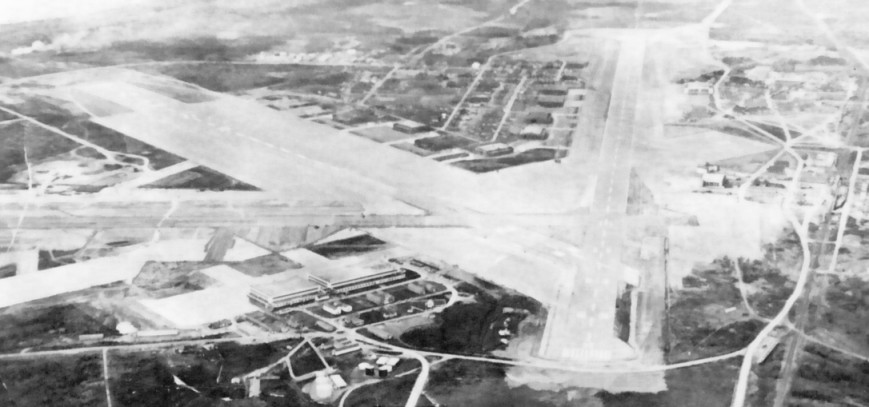
The extremely wide runways and aprons were far in excess of what was needed for landing and dispersal of the few aircraft needed for coastal patrol and convoy escort into the Atlantic.
Why ?
The Ferry Command concept :
Canadian-born British press baron Max Aitken, also known as Lord Beaverbrook,
had the idea of flying multi-engine long range aircraft built in the US
and Canada across the Atlantic. He asked the Canadian Pacific Railway -
a well-organized corporation which ran an airline - to set up an organization
to do this in Montreal (at Dorval Airport). The British Air Ministry was
against this idea, but ... Beaverbrook was in charge of British aircraft
production for the war. Experienced British airline personnel from BOAC also
worked with the mix of civilian and military pilots to help get things going.
(Ferry Command pilots were distinct from freshly-trained combat crews who
sometimes flew their own new bombers over to Europe later in the war)
Ferry Command was a good idea because :
- At the beginning of the war, the German Unterseeboot fleet (U-boats) was doing a much better job of sinking Allied shipping than the Royal Navy was doing of protecting it. The Germans were winning the Battle of the Atlantic.
- Flying boats had shown that four-engine aircraft could travel successfully from Newfoundland to Britain. (However, in-flight refuelling was still too experimental to use. If the aircraft couldn't be fitted with auxiliary tanks, a place like the Azores (Portuguese) was handy for refueling. Often, the prevailing winds were helpful to eastbound fuel economy.)
- Why take up valuable, increasingly scarce ships with big aircraft which can get to Europe on their own ?
- If you need the manufacturing capacity of North America to build planes, it is a waste of effort to break them down and crate them for sea transport ... and then ... reassemble them in Britain !
- So much valuable labour and scarce metal is put into manufacturing aircraft ... can the Allies afford to have entire shiploads of them eternally patrolling the bottom of the Atlantic ?
As a result :
Whole flocks of brand new 2-engined Hudsons ; and 4-engined Flying Fortresses, Liberators and Lancasters landed at Gander waiting for the weather, crew rest, final mechanical adjustments, and the fuel necessary to cross the Atlantic.
Some crew members attended a late afternoon or evening church service, while others went to a movie, or amused themselves with cards, or drank alcohol - but legally : no alcohol less than 12 hours before flying.
Then the crews attended their briefings and prepared for an overnight flight to some assigned airfield in Britain (Prestwick, Scotland at first for the Americans) ... or whatever they could find ... considering the navigation problems, weather, and German bombing raids on British cities. I have assumed that "overnight" means that they were aiming for daylight arrival so they could identify navigation landmarks and land more safely at the airfields.
Gander at Night
The starting squeal, cough, and racing bluster of big engines as they come to life ... one by one ... down the flightline ...
The clouds of smoke and vapour, as the engines warm up into a uniform roar on a cold damp Newfoundland evening ...
The gasoline engines' warm sleepy breath replacing all the cool fresh air ...
The swinging hurricanes of wind - blizzards in winter - from the prop-wash as each turns in sequence, to follow in single file on the taxiway ...
Inside, throttle levers 1 and 4 are gently nudged up and down ... along with a slow clog dance of flying boots on rudder pedals
... as the dark, lumbering birds are coaxed to walk on land ...
The great glass-tipped beaks pointing skyward - the pilots slowly swing tails back and forth just to see ahead ...
Slowly and precisely, the big tail swings 90 degrees ...
Red light.
Final nervous adjustments ... lights in front meet at infinity ... sweat ... time has stopped ...
Green light !
Throttles are raised and held to cheat Death - which still waits patiently at Infinity ...
Propellers claw viciously, vainly, at the night air ...
Then thumbs lift off the brakes and clamp into tightened fists on the yoke ...
First moving slowly ... slowly ... then jarring and shaking faster and faster ... and faster ... faster ... wait ... now easing back ...
Suddenly, the violence is gone but the roar and vibration remain ...
Propeller blades slice spirals and wings slide up a solid wedge of air,
... a small ocean of explosive gasoline is lugged higher into the night.
Black birds in a black sky over a black sea with only dots of light overhead and some internal instinct to guide their migration ...
The black swarm is drawn to the stench of popular delusion, human misery, and death - which has been rising in the east since 1933 ...
Don't blame the birds ...
From the moment of their conception, Nature superbly crafted them to wander the black sky, and drop fire on people to stop misery and death ...
And don't blame the hopeful, brave-scared young men whom the black birds carried into that hell on earth ... again, and again, and again ...
... and then forever in their memories ...
Blame popular delusion.
Blame naked emperors.
Blame naked emperors.
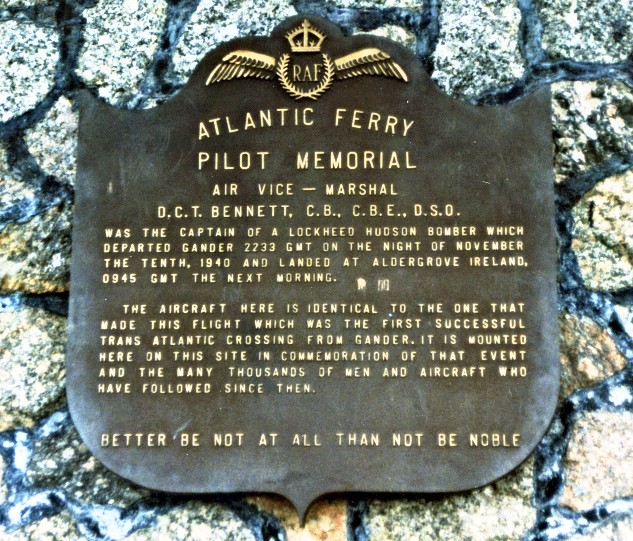
In 1988, it took us a while, but we found the Ferry Command Pilot Memorial at Gander.
Below is the Lockheed Hudson at the memorial.
The first trans-Atlantic delivery of 7 Hudsons from Gander took just over 11 hours to reach Ireland.
Ground crews spent hours chipping ice and snow off the bombers before the flight.
There are 100 war graves at Gander.
Below is the Lockheed Hudson at the memorial.
The first trans-Atlantic delivery of 7 Hudsons from Gander took just over 11 hours to reach Ireland.
Ground crews spent hours chipping ice and snow off the bombers before the flight.
There are 100 war graves at Gander.
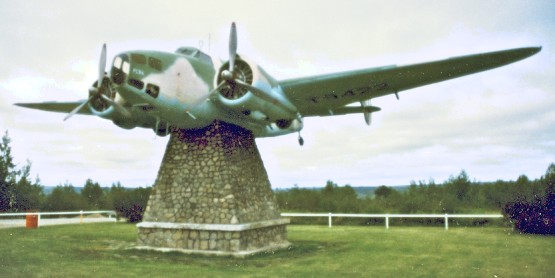
The first army group responsible for base defence in June 1940 was
The Black Watch of Canada 1st Battalion. Their bagpipes are said to have
played for the departure of the first group of American aircraft for Britain.
Around this time, the Canadian government suggested that the airport, if captured by the enemy, could be used to do a lot of damage to Canada and the US. Discussions were held between Britain and Newfoundland and it was decided that on April 1, 1941 the RCAF would take responsibility for the airport as RCAF Station Gander.
Around this time, the Canadian government suggested that the airport, if captured by the enemy, could be used to do a lot of damage to Canada and the US. Discussions were held between Britain and Newfoundland and it was decided that on April 1, 1941 the RCAF would take responsibility for the airport as RCAF Station Gander.
It must have been pretty magical, being a kid at Gander.
Between the planes, trains and people always coming and going, everything was new, changing, and growing every day.
There were no more than 50 children at Gander during the war - so there was a ratio of about 300 adults per child.
- At Christmas, each of the forces had their own celebration for the kids. One year the RCAF Sergeants' Mess brought in kids from nearby Gambo by train to add to the festivities.
- The Americans had their big celebration on July 4.
- Guy Fawkes Day was celebrated each November 5 by Newfoundlanders - something familiar for the visiting RAF personnel, who put on a bonfire and feast for the kids.
- And July 1, Canada's birthday ... was, and is, a day of Remembrance for Newfoundlanders.
They could use the RCAF pool and bowling alley.
After the war, military forces moved out, buildings were reallocated, and kids went to school in the former RCAF tavern.
Flying boats, Coastal Command, and conferences
From a 1942 Royal Air Force article :
"The story of many of these flights upon which aircraft of Coastal Command are constantly engaged must remain a secret until the war is over. Their importance is, indeed, obvious. Commanders-in-Chief have no longer to rely entirely on cipher telegrams or long-distance wireless telephone conversations. They can meet together in conference and together discuss the many problems of the war face-to-face across a table. Then, when the talk is over, the decisions taken, they can enter a flying boat or a Hudson of the Command and return to their posts at the various seats of war."
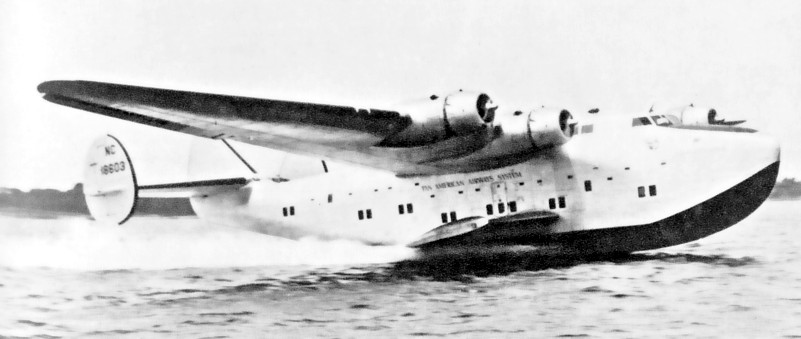
One source suggests that Churchill came through Gander
at least twice - landing at least once on Gander Lake in an aircraft like this.
This is one of the "Pan Am Clippers" - more correctly known as a Boeing 314. In all, 12 Boeing 314s were built.
Britain bought 3 in April 1941, and BOAC operated them. They were named Bristol, Berwick and Bangor.
A quick chronological background to the wartime conferences between leaders :This is one of the "Pan Am Clippers" - more correctly known as a Boeing 314. In all, 12 Boeing 314s were built.
Britain bought 3 in April 1941, and BOAC operated them. They were named Bristol, Berwick and Bangor.
- September 2, 1940 - By executive order, President Franklin Roosevelt sets up the "destroyers for bases" agreement with Britain.
- October 1940 - Britain has won the Battle of Britain - preventing a German invasion across the English Channel - by stopping the Luftwaffe from achieving complete air superiority over the islands. However, British cities will still be hammered by German bombs and V1 cruise missiles in "The Blitz".
- December 1940 - Secure, as he has just won a third presidential term, Franklin Roosevelt declares the US to be "The Arsenal of Democracy " in a "fireside chat" radio broadcast to the US and the world. He suggests that the US can no longer expect to be protected from attack by the Atlantic and Pacific Oceans - given the range of the newest bombers and Hitler's determination to invade country after country.
- March 1941 - FDR's "Lend-Lease Act" passes Congress, empowering the US President to provide the cash or material aid he saw fit to allied countries. Britain's dollar reserves were low and its gold reserves would be the next to go ... In international trade a country must have some method of paying for imports and Britain was running out of cash. To those who wanted to preserve American military and financial neutrality, FDR provided the following memorable parable : If a neighbour's house is burning down, you don't haggle over a price - you lend them your hose and work things out later.
- June 1941 - Hitler invades the USSR, breaking his non-aggression pact with Stalin. The Soviet Union ultimately loses 20 million soldiers and civilians killed in World War 2.
Conferences
Apparently, Roosevelt and Churchill first met to discuss the war at Argentia, Newfoundland in early August 1941. Both were masters of little white lies to fool the enemy ("disinformation") ... and propaganda ... and a big deal was made about FDR spending the time in question fishing off the coast of New England. Later when the meeting was revealed to the public, he and Churchill were said to have sailed aboard their own warships to meet at a secret location for their 3 day conference. Much was also made of Churchill's warships taking detours in the Atlantic to avoid suspected U-boat locations on his way to Argentia. Yes, but it's generally not the U-boat you know about that gets you, so why would that risk have been taken?
Apparently, Roosevelt and Churchill first met to discuss the war at Argentia, Newfoundland in early August 1941. Both were masters of little white lies to fool the enemy ("disinformation") ... and propaganda ... and a big deal was made about FDR spending the time in question fishing off the coast of New England. Later when the meeting was revealed to the public, he and Churchill were said to have sailed aboard their own warships to meet at a secret location for their 3 day conference. Much was also made of Churchill's warships taking detours in the Atlantic to avoid suspected U-boat locations on his way to Argentia. Yes, but it's generally not the U-boat you know about that gets you, so why would that risk have been taken?
Note of caution: I am not a historian with access to archives, or the daybooks and credit card receipts of the leaders ... but ... a lot of ranking Washington war planning military and civilian officials were present at the Argentia conference. I have trouble believing - with the free world threatened by the spit-polished hobnailed Nazi jackboot of tyranny - that all these important people were bobbing around in the middle of the ocean to get to the meeting if they could safely fly in. The British already had the flying boats to do the job.
However, at the time, neither the potent imagery of warships, nor the concept that "Britannia rules the waves" would be allowed to fade away, just because of a few U-boats ...
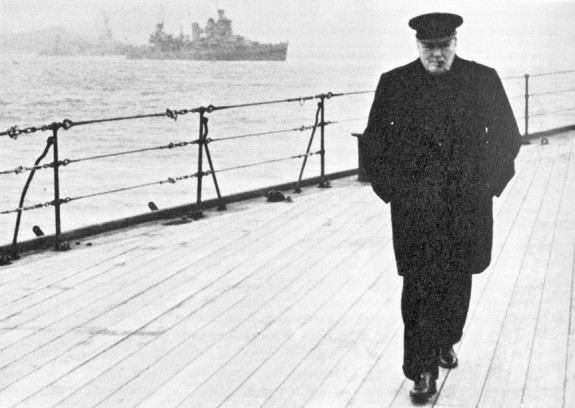
Military photo-op : Churchill at Argentia, Placentia Bay, Newfoundland, aboard HMS Prince of Wales in August 1941.
The Newfoundland shoreline is visible behind the second warship.
Whether or not Churchill flew to Gander and/or the USN air station at Argentia doesn't really matter.
Churchill, Roosevelt and other leaders made many other flights across the Atlantic during World War 2 for conferences at the following locations :
- Moscow September 1941 - Beaverbrook, Harriman, Stalin
- Washington, December 1941 - Churchill, Roosevelt
- Washington, June 1942 - Churchill ("flying boat" reference found), Roosevelt
- Moscow, August 1942 - Churchill, Harriman, Stalin
- Casablanca, January 1943 - Roosevelt, Churchill, de Gaulle ("Roosevelt - Clipper flying boat" reference found)
- Washington, May 1943 - Churchill, Roosevelt
- Quebec, August 1943 - Churchill, Roosevelt, Mackenzie-King ... (like the Mountie's dog, addressed habitually as "King" by Roosevelt)
- Cairo, November 1943 - Churchill, Roosevelt, Chiang Kai-shek
- Tehran, November 1943 - Churchill, Roosevelt, Stalin
- Cairo, December 1943 - Churchill, Roosevelt, Inonu (of Turkey - military minister under Ataturk, statesman, President 1938-50)
- Quebec, September 1944 - Churchill, Roosevelt
- Moscow, October 1944 - Churchill, Stalin, Molotov (tending bar), Eden
- Malta, January 1945 - Churchill, Roosevelt
- Yalta, southern Ukraine, February 1945 - Churchill, Roosevelt, Stalin
- Potsdam, July 1945 - Churchill, Stalin, Truman, Atlee
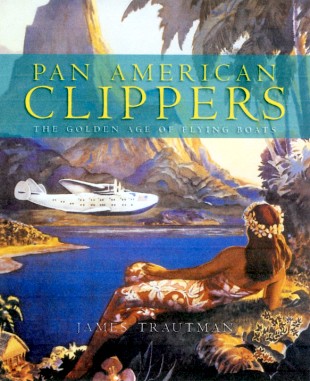 Update: November 2009 Update: November 2009James Trautman, author of the book pictured at the left, published by Boston Mills Press, sent me an interesting update about aspects of wartime travel on the Clippers regarding ... " ... FDR, Casablanca [Conference] and the Clipper. Yes, he did fly on a Pan Am Clipper. He took the train secretly from Washington to Miami, boarded the Yankee Clipper and traveled through Central and South America to Casablanca. On the return flight he celebrated his 61st birthday on the aircraft. On the flight over and back two Pan Am Clippers in the service of the US military were involved. On the flight over he played the famous WWII 'short snorter' game. Churchill played that same game when he came to Newfoundland in 1943. " ... Involving two of the off duty reminders of civilian life ... paper currency and alcohol ... the short snorter game was played by soldiers about to enter action or parting company for a while ... For example, if two friends were playing ... each would have a drink and sign the other's bank note. The next time they got together, the participant who had amassed fewer signatures would buy a round of drinks ... he who was 'short' of signatures bought the other a 'snort'. If several buddies played together, the cost of the round for the loser would be higher. More significantly for the soldiers ... if a comrade was lost ... the signature on the local currency remained a enduring portable keepsake of the last time they had shared a drink together. |
Was there really a serious U-boat threat early in the war to Churchill et al around Argentia and Newfoundland ?
A tragedy of the war for Newfoundland on October 14, 1942 was the sinking by U-69 of the scheduled Newfoundland Railway Port-aux-Basques ferry, Caribou.
Lost were 90 passengers and the entire 46 member crew of the ferry - with only one lifeboat getting off as the ferry sank.
The 46 [sic] member crew of the U-69 were killed east of Newfoundland in early 1943 by depth charges from HMS Fame.
It was on a fast, modern ferry that we returned from our own Newfoundland visit 46 years later : Caribou.
Other air routes across the Atlantic for ferrying aircraft ...
In the end, about 12,000 new aircraft were flown across the Atlantic to the war in Europe.
The US had its own hierarchy - the US Army Air Corps Ferrying Command - ACFC.
Besides using Gander for bombers, they would also take shorter range planes across in short hops via military airstrips at :
- Goose Bay, Labrador
- newly constructed bases in western Greenland
- Reykjavik, Iceland
 .
.About 2000 US aircraft of the total above took a more interesting route to keep things moving when the weather in the North Atlantic was very poor. It was a scenic route which provided extra practice for green crews who were flying over aboard their own bombers : Puerto Rico, Brazil, Ascension Island, Liberia, Morocco and then to England.
Gander after World War 2
Although it almost began before World War 2, trans-Atlantic civil aviation really developed after the war. More advanced radio guidance, and cockpit navigation instruments developed for war, along with aircrew, and supporting professions and trades, were ready to make the transition to peacetime aviation.
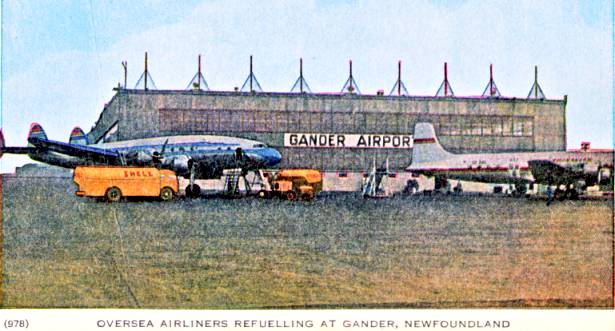
Easy to identify with its triple tail, a Lockheed Constellation is being
refuelled with Shell gasoline - which came through their facilities at Lewisporte.
The building certainly looks like a wartime model.
Below, in a 1957 Government of Canada atlas, Gander was still shown as an important refuelling stop for transatlantic flights. This status continued to decline with the evolution of long range commercial turbojets. You can see four schematic routes heading for the US east coast and one to the Caribbean.
Below, in a 1957 Government of Canada atlas, Gander was still shown as an important refuelling stop for transatlantic flights. This status continued to decline with the evolution of long range commercial turbojets. You can see four schematic routes heading for the US east coast and one to the Caribbean.
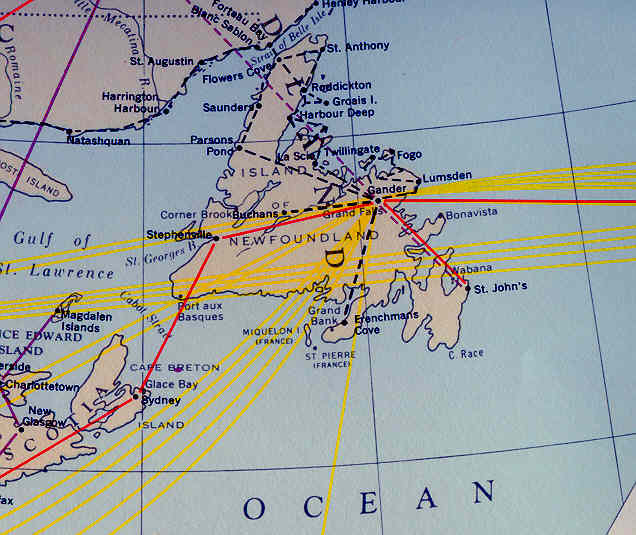
In a 1960s postcard ...the star is probably a stylized representation of all the runways at Gander.
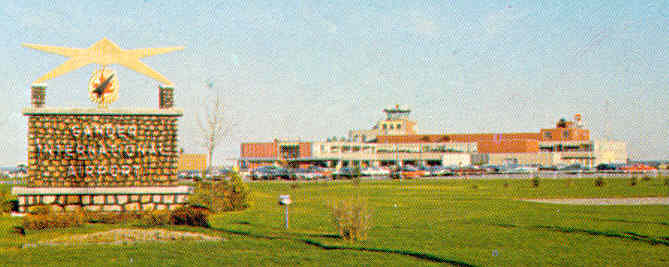
1988
By the time we showed up in Gander
(below) its much shorter list of international clientele featured regular
Soviet and Cuban flights
which were not allowed to swing by the US as they travelled to and from "that imprisoned island" - Cuba
... which people from Quebec like to visit so much.
Around the time of our visit, I read that there were on average each day, 3-4 requests for asylum in Canada by transitting passengers from communist countries.
The article said the RCMP officer at the airport had a standard speech which included the idea that the person could relax because they were in a free country now.
which were not allowed to swing by the US as they travelled to and from "that imprisoned island" - Cuba
... which people from Quebec like to visit so much.
Around the time of our visit, I read that there were on average each day, 3-4 requests for asylum in Canada by transitting passengers from communist countries.
The article said the RCMP officer at the airport had a standard speech which included the idea that the person could relax because they were in a free country now.
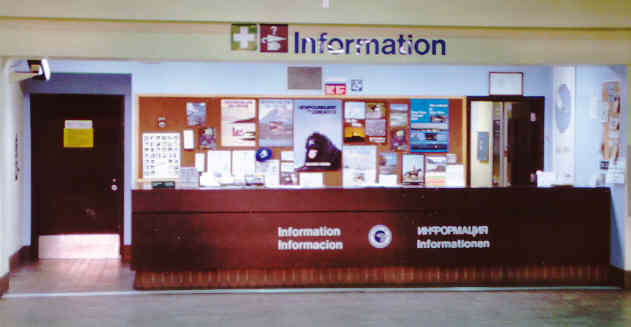
The "Coastal Command tradition" was still alive ... well, except for depth-charging U-boats
... with US Coast Guard, and Canadian International Ice Patrol aircraft present.
... with US Coast Guard, and Canadian International Ice Patrol aircraft present.
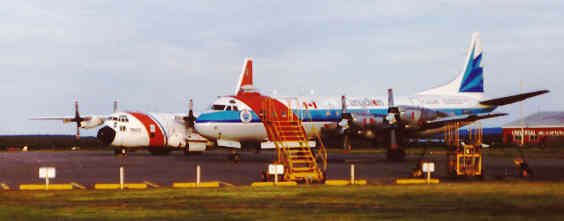
Twilight at Gander

Fifty years after it brought Gander and its airport into the world,
the Newfoundland Railway waits for the end in 1988.
the Newfoundland Railway waits for the end in 1988.